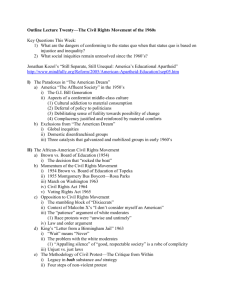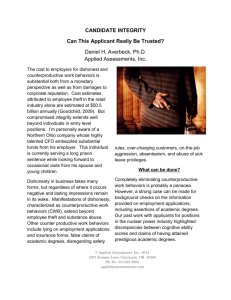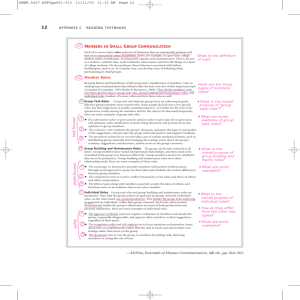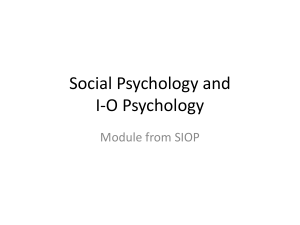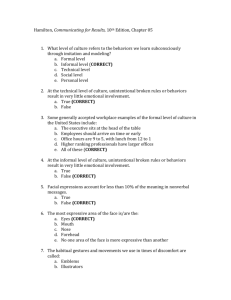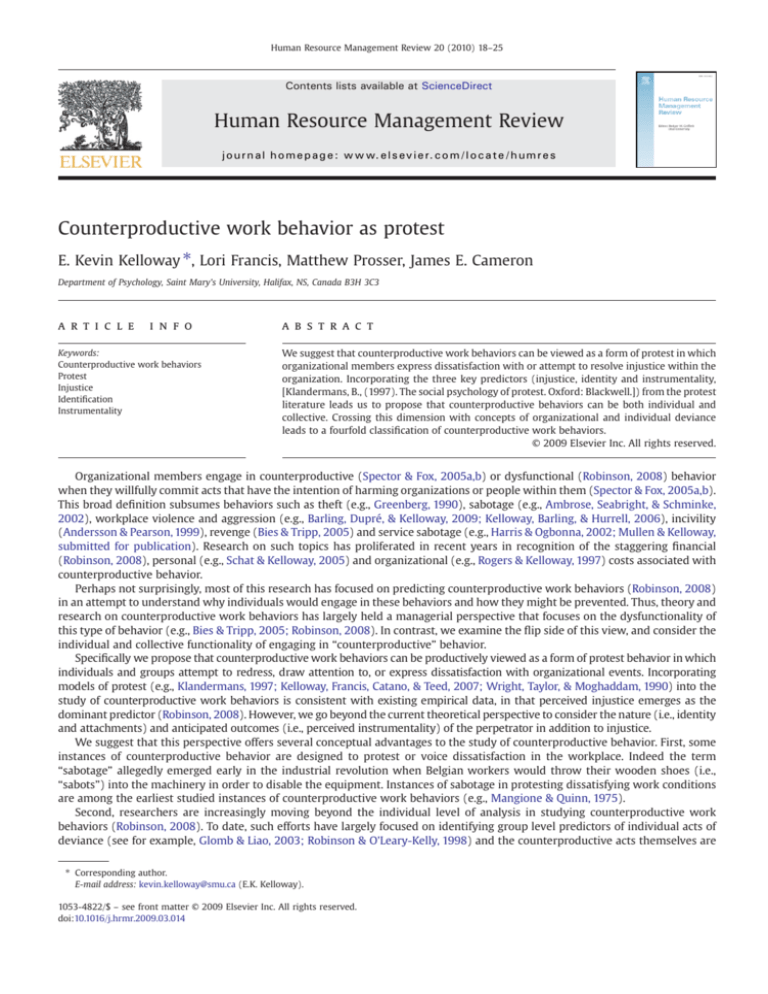
Human Resource Management Review 20 (2010) 18–25
Contents lists available at ScienceDirect
Human Resource Management Review
j o u r n a l h o m e p a g e : w w w. e l s ev i e r. c o m / l o c a t e / h u m r e s
Counterproductive work behavior as protest
E. Kevin Kelloway ⁎, Lori Francis, Matthew Prosser, James E. Cameron
Department of Psychology, Saint Mary's University, Halifax, NS, Canada B3H 3C3
a r t i c l e
i n f o
Keywords:
Counterproductive work behaviors
Protest
Injustice
Identification
Instrumentality
a b s t r a c t
We suggest that counterproductive work behaviors can be viewed as a form of protest in which
organizational members express dissatisfaction with or attempt to resolve injustice within the
organization. Incorporating the three key predictors (injustice, identity and instrumentality,
[Klandermans, B., (1997). The social psychology of protest. Oxford: Blackwell.]) from the protest
literature leads us to propose that counterproductive behaviors can be both individual and
collective. Crossing this dimension with concepts of organizational and individual deviance
leads to a fourfold classification of counterproductive work behaviors.
© 2009 Elsevier Inc. All rights reserved.
Organizational members engage in counterproductive (Spector & Fox, 2005a,b) or dysfunctional (Robinson, 2008) behavior
when they willfully commit acts that have the intention of harming organizations or people within them (Spector & Fox, 2005a,b).
This broad definition subsumes behaviors such as theft (e.g., Greenberg, 1990), sabotage (e.g., Ambrose, Seabright, & Schminke,
2002), workplace violence and aggression (e.g., Barling, Dupré, & Kelloway, 2009; Kelloway, Barling, & Hurrell, 2006), incivility
(Andersson & Pearson, 1999), revenge (Bies & Tripp, 2005) and service sabotage (e.g., Harris & Ogbonna, 2002; Mullen & Kelloway,
submitted for publication). Research on such topics has proliferated in recent years in recognition of the staggering financial
(Robinson, 2008), personal (e.g., Schat & Kelloway, 2005) and organizational (e.g., Rogers & Kelloway, 1997) costs associated with
counterproductive behavior.
Perhaps not surprisingly, most of this research has focused on predicting counterproductive work behaviors (Robinson, 2008)
in an attempt to understand why individuals would engage in these behaviors and how they might be prevented. Thus, theory and
research on counterproductive work behaviors has largely held a managerial perspective that focuses on the dysfunctionality of
this type of behavior (e.g., Bies & Tripp, 2005; Robinson, 2008). In contrast, we examine the flip side of this view, and consider the
individual and collective functionality of engaging in “counterproductive” behavior.
Specifically we propose that counterproductive work behaviors can be productively viewed as a form of protest behavior in which
individuals and groups attempt to redress, draw attention to, or express dissatisfaction with organizational events. Incorporating
models of protest (e.g., Klandermans, 1997; Kelloway, Francis, Catano, & Teed, 2007; Wright, Taylor, & Moghaddam, 1990) into the
study of counterproductive work behaviors is consistent with existing empirical data, in that perceived injustice emerges as the
dominant predictor (Robinson, 2008). However, we go beyond the current theoretical perspective to consider the nature (i.e., identity
and attachments) and anticipated outcomes (i.e., perceived instrumentality) of the perpetrator in addition to injustice.
We suggest that this perspective offers several conceptual advantages to the study of counterproductive behavior. First, some
instances of counterproductive behavior are designed to protest or voice dissatisfaction in the workplace. Indeed the term
“sabotage” allegedly emerged early in the industrial revolution when Belgian workers would throw their wooden shoes (i.e.,
“sabots”) into the machinery in order to disable the equipment. Instances of sabotage in protesting dissatisfying work conditions
are among the earliest studied instances of counterproductive work behaviors (e.g., Mangione & Quinn, 1975).
Second, researchers are increasingly moving beyond the individual level of analysis in studying counterproductive work
behaviors (Robinson, 2008). To date, such efforts have largely focused on identifying group level predictors of individual acts of
deviance (see for example, Glomb & Liao, 2003; Robinson & O'Leary-Kelly, 1998) and the counterproductive acts themselves are
⁎ Corresponding author.
E-mail address: kevin.kelloway@smu.ca (E.K. Kelloway).
1053-4822/$ – see front matter © 2009 Elsevier Inc. All rights reserved.
doi:10.1016/j.hrmr.2009.03.014
E.K. Kelloway et al. / Human Resource Management Review 20 (2010) 18–25
19
almost always defined as the behavior of individuals (e.g., Spector, Fox, & Domagalski, 2006). However, much of the literature on
protest behaviors focuses on collective action (e.g., Van Zomeren, Postmes, and Spears, 2008) and we suggest that
counterproductive behaviors can encompass both individual and collective behaviors. Some examples of collective counterproductive behaviors (e.g., work-slow campaigns, work to rule, co-ordinated sick days) are instituted within the domain of
industrial relations and we recognize that defining them as counterproductive is a political decision (Spector & Fox, 2005a,b) —
what is counterproductive for the organization may be productive or functional for the individual or group. Other forms of
collective counterproductive behavior may include mobbing (e.g., Leymann, 1996; Zapf & Einarsen, 2005) or bullying (Rayner &
Cooper, 2006), and collective acts of violence that occur in the context of a labor dispute (Francis, Cameron, & Kelloway, 2006).
Finally, we suggest that examining counterproductive behaviors as protest behaviors responds to Robinson's (2008) calls for more
integration, consideration of motivations, and consideration of consequences in the study of dysfunctional work behaviors. We draw
heavily on the social identity model of collective action proposed by Van Zomeren et al. (2008) to formulate an integrative model of
counterproductive behavior that explicitly considers the motives and expectancies of actors at both the individual and group levels. In
developing this model, we first briefly review the nature of counterproductive behaviors and the literature on protest behaviors. We
then integrate these two literatures in proposing a model of counterproductive behaviors as protest.
1. Defining counterproductive behaviors
There are a number of ways to conceptualize counterproductive behaviors. Prior to the mid 1990s, the most common approach was
to examine individual dysfunctional behaviors with no suggestion of an overarching construct. For example, individuals studied topics
such as lateness (Blau, 1995), workplace violence (Rogers & Kelloway, 1997), sabotage (Mangione & Quinn, 1975), theft (Greenberg,
1990), and absenteeism (e.g., Johns, 1994) with little recognition that these disparate behaviors may reflect some commonality. A more
integrative view was proposed by Robinson and Bennett (1995) whose typology of deviant behavior in organizations conceptualized
deviance as incorporating disparate behaviors organized according to the nature of the target (i.e., individual vs. organizational) and the
severity of the behavior. Their typology validated the work of a number of earlier researchers (e.g., Hollinger & Clark, 1982; Wheeler,
1976) and further germinated a fount of research ranging from bullying (Lavan & Martin, 2007), cyber-loafing (Blanchard & Henle,
2008; Blau, Yang, & Ward-Cook, 2006), workplace violence (Kelloway et al., 2006), organizational ethics (Brown & Trevino, 2006),
sabotage (Ambrose et al., 2002), citizenship behavior (Lee & Allen, 2002), counterproductive workplace behavior (Fox, Spector, & Miles,
2001), and incivility (Cortina, Magley, Williams, & Langhout, 2001) to name a few.
Drawing on Kaplan's (1975) notion of organizationally specific norms, Robinson and Bennett (1995) defined workplace
deviance as behavior that voluntarily violates organizational norms, thereby threatening the well-being of members and the
organization itself. Thus, according to this framework workplace deviance is not defined in terms of any system of moral standards,
rather such behavior deviates from the formal and informal norms as prescribed by procedure, policy, and rules. Further, this
approach asserts that to be considered deviant behavior must have at least the potential to harm either the well-being of the
organization or its members, thereby excluding breaches of decorum such as poor manners and other social blunders.
Stemming from this working definition and an earlier classification by Hollinger (1986), Hollinger & Clark (1982), Robinson and
Bennett (1995) presented a comprehensive typology comprising two dimensions in which any behavior that fits the definition can
be categorized and differentiated from other deviant actions. The first dimension types deviant behavior according to its severity,
ranging from minor to severe. Some deviant behavior, such as a worker talking with coworkers instead of working, would be
classified as a minor deviant act. Other incidents, such as a physical assault, would be classified as severe.
The second dimension types deviant behavior according to the target, such that the behavior may be harmful to an individual's
(interpersonal deviance) or the organization's well-being (organizational deviance). Crossing these two dimensions results in four
quadrants in which to classify deviant behavior. These are labeled as Production Deviance (low severity, organizational target, e.g.,
leaving early or taking too many breaks), Property Deviance (high in severity, organizational target, e.g., stealing or accepting
kickbacks), Political Deviance (low in severity, individual target, e.g., gossiping or counterproductive competition), and Personal
Aggression (high in severity, interpersonal target, e.g. verbal abuse or sexual harassment).
A measure based on this typology (Bennett & Robinson, 2000) comprised two dimensions based on the target of deviant acts,
with each subscale incorporating a range of behaviors in terms of severity. Some have challenged both the typology and the
measure in part because interpersonal deviance and organizational deviance are highly correlated (r = .62), perhaps reflecting an
artifact precipitated by the common use of both the typology and measure (Berry, Ones, & Sackett, 2007). Others (Sackett &
DeVore, 2002) have criticized the model because it was developed from employees' perceptions of the similarity of deviant
behaviors (using the multi-dimensional scaling technique) rather than from quantitative covariance between actual deviant
behaviors (using factor analysis). Other researchers have subsequently elaborated the structure of workplace deviance to
incorporate dimensions such as relevance of the associated task (Gruys & Sackett, 2003) and behavior specific domains such as
alcohol and drug use (Sackett & DeVore, 2002). However, Robinson and Bennett's (1995) model and its associated measure
(Bennett & Robinson, 2000) dominates the literature (c.f. Berry, Ones & Sackett, 2007 meta-analysis) and we draw heavily on this
model as we explore the ways in which counterproductive work behavior might reflect a type of protest.
2. A model of protest
Research on organizational injustice suggests the importance of deontological accounts for understanding how individuals
respond to organizational events (e.g., Cropanzano, Goldman, & Folger, 2003). That is, researchers are urged to recognize that
20
E.K. Kelloway et al. / Human Resource Management Review 20 (2010) 18–25
individuals are sensitive to the moral or ethical appropriateness of events. One response to the perceived violation of ethical or
moral standards is to protest the action. Klandermans (1997, 2002) presented an influential model of social protest comprising
three factors: perceived injustice, instrumentality, and identification with a group. He suggests that individuals are likely to engage
in social protest when they perceive that it will be effective in addressing an injustice targeted at a group with whom they identify.
Somewhat analogous to Klandermans' model, Opp et al. (e.g., Opp, 1998; Opp & Gern, 1993) noted that discontent with the
distribution goods and a sense that protest can influence change are incentives to protest. Empirical support for Klandermans'
three factor model has emerged in a variety of studies including investigations of why people participate in large scale collective
action (i.e., rallies, Kelloway et al., 2007) or offer support for industrial action (i.e., strikes, Kelloway, Francis, Catano, & Dupré,
2008). Meta-analytic evidence also supports the importance of these three predictors of collective action (e.g., Van Zomeren et al.,
2008). In the current paper this three factor framework for understanding protest is applied to understanding why individuals
engage in counterproductive work behaviors.
2.1. Injustice
In the common protest cry of “no justice, no peace” the core meaning of perceived injustice as a motivator for social protest is
made explicit. Certainly, the empirical data support the view that perceived injustice is a necessary starting point for protest
(Kelloway et al., 2007, 2008; Klandermans, 1997, 2002; Opp, 1998; Opp & Gern, 1993; Van Zomeren et al., 2008). Organizational
justice theory identifies several types of perceived injustice, including assessments of the perceived fairness of outcomes
(distributive justice, Adams, 1965), the fairness of decision making processes (procedural justice, Leventhal et al., 1980), and the
fairness of interpersonal treatment (interactional justice, Bies & Moag, 1986). Although the majority of justice research has
taken a first person perspective, research does illustrate, consistent with a deontic view (Cropanzano et al., 2003; Folger &
Skarlicki, 2005), that individuals can be sensitive to and have empathy for injustices experienced by others (e.g., coworkers,
Kray & Lind, 2002).
In the face of experienced or witnessed unfairness individuals may make behavioral attempts to restore justice. With respect to
outcomes that are viewed as unjust, attempts may be made to alter the outcome itself or the amount of effort invested in a task
(Adams, 1965; Cropanzano & Greenberg, 1997). Following a procedural injustice, individuals may increase efforts to have their
voice heard in the process in question (Thibault & Walker, 1975, Leventhal et al., 1980). Interactional injustice may prompt
individuals to reciprocate uncivil interpersonal treatment (Andersson & Pearson, 1999).
Perhaps not surprisingly, organizational researchers have consistently documented an association between perceived
organizational injustice and counterproductive work behaviors (see for example, Berry et al., 2007; Cohen-Charash & Spector,
2001; Colquitt, Conlon, Wesson, Porter, & Ng, 2001). The suggestion has been that individuals may engage in some forms of
counterproductive behavior (e.g., theft, Greenberg, 1990) in an attempt to restore some sense of equity or fairness. Although some
reviewers accord a primary role to injustice as a “cause” of counterproductive work behaviors, recent meta-analytic evidence tends
to suggest that individual differences are more strongly correlated with counterproductive behavior than are perceptions of
injustice (Berry et al., 2007), pointing to the possibility that situational and individual factors interact to predict counterproductive
work behaviors (see also, Bies & Tripp, 2005).
2.2. Instrumentality
Perceived effectiveness or instrumentality of protest is a second component of Klandermans' (1997, 2002) model of social
protest. People engage in collective actions when they see such actions as being likely to achieve relevant goals (Van Zomeren
et al., 2008). Again, empirical support for the value of instrumentality perceptions in predicting protest continues to grow (Van
Zomeren et al., 2008). For example, perceived instrumentality predicted participation in student rallies (Kelloway et al., 2007)
and support for striking workers (Kelloway et al., 2008). Indeed, perceived instrumentality was the single best predictor of
participation in a student rally (Kelloway et al., 2007).
As a vital component of models of protest, perceived instrumentality is not limited to the potential to right a wrong or
necessarily restore distributive justice in a tangible way. Rather, protest activities, which we argue includes counterproductive
work behaviors, can be viewed as instrumental when they serve to express dissatisfaction with the current state of affairs or draw
attention to an unjust practice. Accordingly, it is important to incorporate multiple instrumentalities into the prediction of
counterproductive work behaviors.
This view is consistent with Hirschman's (1970) seminal work on exit, voice and loyalty. He points out that individuals
who experience dissatisfaction or injustice have at least two choices, to leave the situation or to express their displeasure at
the circumstances. Hirschman (1970) essentially suggested that those who were psychologically attached to, or loyal to, the
organizational would respond with voice while those who had no such attachment would simply leave the organization:
“Loyalty holds exit at bay and activates voice” (p. 78). Noting that the predictions of the model involving loyalty were
problematic, and that individuals often psychologically detach from the organization prior to their actual departure, Burris,
Detert and Chiaburu (2008) found that detachment led to increased voice rather than to exit. In a similar manner, we
suggest that the individual's identification with the organization plays a key role in predicting counterproductive work
behaviors.
E.K. Kelloway et al. / Human Resource Management Review 20 (2010) 18–25
21
2.3. Identification
Identification with a group is an important aspect of the decision to engage in social protest (De Weerd & Klandermans, 1999;
Klandermans, 1997; Van Zomeren et al., 2008). For example, recent studies show that identification with a union predicts both
participation in student protest (Kelloway et al., 2007) and third party support for strike action (Kelloway et al., 2008). In the social
identity tradition, identification is defined as “that part of an individual's self-concept which derives from…knowledge of…
membership of a social group (or groups) together with the value and emotional significance attached to that membership” (Tajfel,
1978, p. 63). Whereas the organization is an important source of self-definition and self-esteem for its members, individuals can
also identify with multiple groups nested within the organization, such as their department and their work team (for a review, see
Ashforth, Harrison, & Corley, 2008).
Traditional models of protest rely heavily on the notion of collective action (Klandermans, 2002; Van Zomeren et al., 2008).
Collective action occurs any time a group member “is acting as a representative of the group and the action is directed at
improving the conditions of the entire group” (Wright et al., 1990, p. 995). Indeed, a high degree of identification with the group
in question would promote participation in collective action on behalf of the group.
We also recognize that many cases of deviant behavior in organizations involve a person acting in response to his or her
individual, rather than group, experiences. To that extent we suggest one might conceptualize protest as individual in cases where
injustice is perceived as uniquely experienced by the self, and not by the members of some social group, or when it stems from
interpersonal, as opposed to intergroup, social comparisons or egoistical, as opposed to fraternal, relative deprivation (cf.
Runciman, 1966; Smith & Ortiz, 2002). Similarly, Wright's (2001) model recognized individual, as well as collective, action as a
potential behavioral response following a perceived disadvantage.
Models of legitimate and, typically victimless, protest have largely focused on how identification with the victims, usually
groups of individuals promotes protest participation (Klandermans, 2002; Van Zomeren et al., 2008). In contrast to normative
protest, non-normative protest typically violates implicit rules or formal laws within a given cultural context (e.g., Dion, 1986;
Lalonde & Cameron, 1994; Martin, 1986; Taylor, Moghaddam, Gamble, & Zellerer, 1987; Wright, 2001; Wright et al., 1990).
Individuals or group members might be more likely to opt for non-normative protest when normative options are unavailable or
unsuccessful (e.g., Kawakami & Dion, 1995) or when they are faced with high degrees of perceived illegitimacy, unfairness, or
discrimination (e.g., Wright et al., 1990). By definition, counterproductive workplace behavior violates organizational norms;
thus we suggest that it reflects non-normative protest for individuals or groups who feel they lack legitimate protest options or
feel particularly maltreated.
In our analysis of counterproductive work behavior as protest, we recognize that this type of deviant workplace activity
comprises non-normative acts that typically bring harm to some individual or group. Thus, we propose that a concomitant lack
of identification with the target is a predictor of protest in the form of counterproductive work behaviors. Certainly, this
proposal follows from studies of hate or prejudice that have consistently identified a negation of intimacy (Sternberg, 2005) or
devaluation (Dovideo, Gaertner & Pearson, 2005; Staub, 2005) of others as a necessary condition for acts of interpersonal
aggression. Specifically, we suggest that to engage in counterproductive work behaviors one must simultaneously identify with
the victim of an injustice, be it one's self or another person or group, and feel alienated from, or devalue, the perceived
perpetrator of the injustice.
Finally, Van Zomeren et al.'s (2008) meta-analysis found support for the importance of each of these three predictors of
collective action: injustice, instrumentality and identification. However, they also proposed, and found support for, a model that
accorded a more central role to identification. Specifically, they found that identification predicted engagement in collective
action directly but also indirectly. That is, identification enhanced perceptions of injustice as well as the perception that
collective action would be efficacious in achieving the goal. Thus, in their model, identification with the victim plays a central
role in predicting collective action. We extend this analysis by suggesting that identification with the victim and a lack of
identification with the target leads to specific predictions of counterproductive behavior.
3. Counterproductive work behavior as protest
We make the argument that counterproductive work behavior, such as theft, sabotage and aggression are a form of protest that are
functional in reaching some desired end for individuals in organizations. Drawing from accepted definitions of counterproductive work
behavior (Fox & Spector, 2005) and established models of protest, we forward the view that counterproductive behavior is a nonnormative form of protest stemming, at least in part, from having a high degree of identification with a victim of an injustice and a low
degree of identification with the target of the behavior.
The framework we use to guide of consideration of counterproductive work behavior as a form of protest is presented in Fig. 1. We
arrived at this model by considering a quality of the target and a quality of the actor of counterproductive work behavior. It is generally
accepted that the targets of counterproductive work behavior can be either organizations or individuals (Bennett & Robinson, 2000;
Berry et al., 2007; Robinson & Bennett, 1995). Thus, one of our proposed dimensions is the identity of the target (organization vs.
individual). In either case we suggest that the target must be seen as a source of injustice to the perpetrator or others in the workplace.
Moreover, we hypothesize that the actor or perpetrator of the counterproductive behavior must have a low level of identification with
the target, and a high level of identification with the victim to result in the counterproductive behavior.
We have also argued that counterproductive work behavior can be either individually enacted or a collective action.
Therefore, our second proposed dimension is whether the protest is individual or group based behavior. The distinction here is
22
E.K. Kelloway et al. / Human Resource Management Review 20 (2010) 18–25
Fig. 1. Framework of counterproductive behavior as protest.
how many individuals engage in the counterproductive behavior simultaneously. Collective action presupposes a degree of
organization and, by extension, the existence of a relevant group that may be defined demographically, or in terms of workplace
organization (e.g., work teams, occupations) or more formally (e.g., trade unions).
4. Individual action, organizational target
Robinson and Bennett (1995) described a number of deviant behaviors targeted at organizations, including leaving early,
working slow on the minor side of severity and sabotaging equipment or stealing on the less serious side. These correspond to their
cells of Production Deviance and Property Deviance but have been represented empirically as one measure of organizational
deviance (Bennett & Robinson, 2000). We note that these are all behaviors that can be enacted by individuals with varied motives
including restoring equity or bringing harm to the organization. Through the lens of protest we argue that those who engage in
individual acts of organizationally targeted protest are retaliating against a perceived organizational injustice that has happened to
the individual or to a individual/group with whom the individual identifies.
With whom might the individual actor identify? It is possible that he or she engages in counterproductive or deviant workplace
behavior to restore a perceived inequity or injustice that is considered to be largely unique or individual. It is also possible that this
individual would respond because of a perceived injustice targeted toward an individual or group (e.g., work team) with whom he
or she does identify. Individually enacted, organizationally targeted counterproductive work behavior would carry a number of
potential benefits of the individual, including a sense of restored equity, either though individual gain (as in the case of theft) or
organizational harm (as in the case of sabotage).
5. Collective action, organizational target
Organizationally targeted counterproductive workplace behavior can also be enacted by groups. Groups might be those that are
formally recognized within the organization (e.g., union, work team) or ad hoc collectives (e.g., coworkers, friends). These groups
might overlap as in the case of a wildcat strike i.e., a strike that is enacted by members of a labor union but is not sanctioned by the
formal structure of the union. Some activities that fall in this category are in fact normative forms of protest. For instance, in
unionized workplaces, legal strikes and work to rule campaigns are strategies used in the collective bargaining process to enable
contract negotiations that benefit employees. Recognizing that strikes or work to rule are functional for the unions and union
members, they nonetheless run counter to the organization's productivity and profits and to that extent illustrate
counterproductive work behavior.
Not all activities within this category need reflect normative or organized forms of protests. Certainly, many of the activities in
this category would be most notable non-normative. Individuals may act together to engage in serious counterproductive behavior
like sabotage or theft or more minor types of deviance including working slowly or taking long lunch breaks. These activities may
be efforts to right an injustice or disadvantage experienced by the group or its members. They might also be expressions of voice
wherein the goal is simply to draw attention to an issue or perceived injustice.
E.K. Kelloway et al. / Human Resource Management Review 20 (2010) 18–25
23
What identity alignments might explain this type of action? Certainly, identification with organization would be low, at least
lower than that to the group in question. At the same time, identification with the perceived victim of injustice or relevant group
would be expected to be high or at least higher than that to the employing organization. That is, such behaviors would be expected
when the group has identified a form of counterproductive behavior as being instrumental and when individuals identify more
strongly with the group than with the employing organization.
6. Individual action, individual target
Acts of interpersonal violence or aggression (Barling et al., 2009; Schat & Kelloway, 2005) including acts of incivility (Anderson
& Pearson, 1996) have attracted a great deal of research attention in recent years under a variety of rubrics (Kelloway et al., 2006;
Schat & Kelloway, 2005). Felson (2006, p. 16) notes the multiplicity of motives for such behaviors when he says that individuals
engage in violent and aggressive behavior because “they can [a] force others to comply, [b] restore justice when they believe that
they have been wronged, [c] achieve a desired image or reputation or [d] entertain themselves with a potentially risky activity.” We
suggest that such individually targeted aggression requires a degree of detachment, or alienation, from the victim. As noted above
negation of intimacy (Sternberg, 2005) or devaluation (Dovideo et al., 2005; Staub, 2005) of others has been identified as a
necessary condition for acts of interpersonal aggression.
7. Collective action, individual target
Groups within organizations might also work together to target individuals who are seen as either (a) the source of injustice
(e.g., an overly harsh or punitive supervisor) or (b) being an outsider in terms of group membership. Examples of such behaviors
might include both mobbing and bullying behaviors that are enacted by many but targeted at specific individuals. Again, engaging
in such behaviors requires both identification with the group and a detachment from the individual who is identified as a target.
Hostile work climates that endorsed incivility and sexual harassment toward women (e.g., Miner-Rubino & Cortina, 2007) may also
be seen as a form of collective action targeted toward individuals or identified groups within the organization.
8. Summary
We have suggested that counterproductive work behaviors can be viewed as a form of protest within organizations. We do not
find it necessary to insist that all forms of counterproductive behaviors are protest, merely that such behaviors may be a means of
protesting injustice. While this view underscores the importance of perceived injustice as a predictor of counterproductive
behaviors (e.g., Robinson, 2008), it also leads us to consider identification and instrumentality as additional predictors. In doing so
we are led to consider the heretofore overlooked suggestion that counterproductive behaviors can be both individually and
collectively enacted. Crossing this dimension with the established distinction between organizational and individual deviance
leads to a fourfold classification that we suggest is useful in understanding the etiology of counterproductive work behaviors.
Acknowledgement
Preparation of this manuscript was supported by funding from the Social Sciences and Humanities Research Council of Canada.
References
Adams, J. S. (1965). Inequity in social exchange. In L. Berkowitz (Ed.), Advances in experimental social psychology, Vol. 2 (pp. 267−299). New York: Academic Press.
Ambrose, M. L., Seabright, M. A., & Schminke, M. (2002). Sabotage in the workplace: The role of organizational injustice. Organizational Behavior and Human
Decision Processes, 89, 947−965.
Andersson, L. M., & Pearson, C. M. (1999). Tit-for-tat? The spiraling effect of incivility in the workplace. Academy of Management Review, 24, 452−471.
Ashforth, B. E., Harrison, S. H., & Corley, K. G. (2008). Identification in organizations: An examination of four fundamental questions. Journal of Management, 34,
325−374.
Barling, J., Dupré, K., & Kelloway, E. K. (2009). Predicting workplace violence and aggression. Annual Review of Psychology, 60, 671−692.
Bennett, R. J., & Robinson, S. L. (2000). Development of a measure of workplace deviance. Journal of Applied Psychology, 85, 349−360.
Berry, C. M., Ones, D. S., & Sackett, P. R. (2007). Interpersonal deviance, organizational deviance, and their common correlates: A review and meta-analysis. Journal
of Applied Psychology, 92, 410−424.
Bies, R. J., & Moag, J. F. (1986). Interactional Justice: Communication Criteria of Fairness. In R. J. Lewicki, B. H. Sheppard, & M. H. Bazeman (Eds.), Research on
Negotiations in Organizations (pp. 43–55). Greenwich, CT: JAI Press.
Bies, R. J., & Tripp, T. M. (2005). The study of revenge in the workplace: Conceptual, ideological, and empirical issues. In P. E. Spector & S. Fox (Eds.), Counterproductive work behavior: Investigation of actors and targets (pp. 65−105). Washington, DC: APA Books.
Blanchard, A. L., & Henle, C. A. (2008). Correlates of different forms of cyberloafing: The role of norms and external locus of control. Computers in Human Behavior,
24, 1067−1084.
Blau, G. (1995). Influence of group lateness on individual lateness: A cross level examination. Academy of Management Journal, 38, 1483−1495.
Blau, G., Yang, Y., & Ward-Cook, K. (2006). Testing a measure of cyberloafing. Journal of Allied Health, 35, 8−17.
Brown, M., & Trevino, L. K. (2006). Ethical leadership: A review and future directions. Leadership Quarterly, 17, 595−616.
Burris, E. R., Detert, J. R., & Chiaburu, D. S. (2008). Quitting before leaving: The mediating effect of psychological attachment and detachment on voice. Journal of
Applied Psychology, 93, 912−922.
Cohen-Charash, Y., & Spector, P. E. (2001). The role of justice in organizational: A meta-analysis. Organizational Behavior and Human Decision Processes, 86,
278−321.
24
E.K. Kelloway et al. / Human Resource Management Review 20 (2010) 18–25
Colquitt, J. A., Conlon, D. E., Wesson, M. H., Porter, C. O. L. H., & Ng, K. Y. (2001). Justice at the millennium: A meta-analytic review of 25 years of organizational justice
research. Journal of Applied Psychology, 86(3), 425−445.
Cortina, L. M., Magley, V. J., Williams, J. H., & Langhout, R. D. (2001). Incivility in the workplace: Incidence and impact. Journal of Occupational Health Psychology, 6,
64−80.
Cropanzano, R., & Greenberg, J. (1997). Progress in organizational justice: Tunneling through the maze. In C. L. Cooper & I. T. Robertson (Eds.), International Review
of Industrial and Organizational Psychology, vol. 12 (pp. 317– 372). London: John Wiley.
Cropanzano, R., Goldman, B., & Folger, R. (2003). Deontic justice: the role of moral principles in workplace fairness. Journal of Organizational Behavior, 24,
1019−1024.
De Weerd, M., & Klandermans (1999). Group identification and political protest: Framers' protest in the Netherlands. European Journal of Social Psychology, 29,
1073−1095.
Dion, K. L. (1986). Responses to perceived discrimination and relative deprivation. In J. M. Olson, C. P. Herman, & M. P. Zanna (Eds.), Relative deprivation and social
comparison: The Ontario symposium, Vol. 5 (pp. 159−179). Hillsdale, NJ: Erlbaum.
Dovideo, J. F., Gaertner, S. L., & Pearson, A. R. (2005). On the nature of prejudice: The psychological foundations of hate. In R. J. Sternberg (Ed.), The psychology of hate
(pp. 211−234). Washington DC: APA Books.
Folger, R., & Skarlicki, D. (2005). Beyond Counterproductive Work Behavior: Moral Emotions and Deontic Retaliation Versus Reconciliation. In Suzy Fox & P. Spector,
(Eds.), Counterproductive work behavior: Investigations of actors and targets (pp. 83–105). Washington, DC, US: American Psychological Association.
Fox, S., Spector, P. E., & Miles, D. (2001). Counterproductive work behavior (CWB) in response to job stressors and organizational justice: Some mediator and
moderator tests for autonomy and emotions. Journal of Vocational Behavior, 59, 291−309.
Francis, L., Cameron, J. E., & Kelloway, E. K. (2006). Picket line violence. In E. K. Kelloway, J. Barling & J. J. Hurrell (Eds.), Handbook of workplace violence (pp. 231−260).
Thousand Oaks, CA: SAGE Publications.
Glomb, T., & Liao, H. (2003). Interpersonal aggression in work groups: Social influence, reciprocal and individual effects. Academy of Management Journal, 46,
486−496.
Greenberg, J. (1990). Employee theft as a reaction to underpayment inequity: The hidden cost of pay cuts. Journal of Applied Psychology, 75, 561−568.
Gruys, M. L., & Sackett, P. R. (2003). Investigating the dimensionality of counterproductive work behavior. International Journal of Selection and Assessment, 11,
30−42.
Harris, L. C., & Ogbanna, E. (2002). Exploring service sabotage: The antecedents, types and consequences of frontline, deviant, antiservice behaviors. Journal of
Service Research, 4, 163−183.
Hirschman, A. O. (1970). Exit, voice, and loyalty: Responses to decline in firms, organizations, and states. Cambridge, MA: Harvard University Press.
Hollinger, R. C. (1986). Acts against the workplace: Social bonding and employee deviance. Deviant Behavior, 7, 53−75.
Hollinger, R. C., & Clark, J. P. (1982). Formal and informal social controls of employee deviance. Sociological Quarterly, 23, 333−343.
Johns, G. (1994). Absenteeism estimates by employees and managers: Divergent perspectives and self-serving perceptions. Journal of Applied Psychology, 79,
229−239.
Kaplan, H. B. (1975). Self-attitudes and deviant behavior. Pacific Palisades, CA: Goodyear.
Kawakami, K., & Dion, K. L. (1995). Social identity and affect as determinants of collective action: Toward an integration of relative deprivation and social identity
theories. Theory & Psychology, 5, 551−577.
Kelloway, E. K., Barling, J., & Hurrell, J. J. (2006). Handbook of workplace violence. Thousand Oaks, CA: SAGE Publications.
Kelloway, E. K., Francis, L., Catano, V. M., & Dupré, K. (2008). Third party support for strike action. Journal of Applied Psychology, 93, 806−817.
Kelloway, E. K., Francis, L., Catano, V. M., & Teed, M. (2007). Predicting protest. Basic and Applied Social Psychology, 29, 13−22.
Klandermans, B. (1997). The social psychology of protest. Oxford: Blackwell.
Klandermans, B. (2002). How group identification helps to overcome the dilemma of collective action. The American Behavioral Scientist, 45, 887−900.
Kray, L. J., & Lind, E. A. (2002). The injustices of others: Social reports and the integration of others' experiences in organizational justice judgments. Organizational
Behavior and Human Decision Processes, 89, 906−924.
Lalonde, R. N., & Cameron, J. E. (1994). Behavioral responses to discrimination: A focus on action. In M. P. Zanna & J. M. Olson (Eds.), The psychology of prejudice: The
Ontario symposium, Vol. 7 (pp. 257−288). Hillsdale, NJ: Erlbaum.
Lavan, H., & Martin, M. W. (2007). Bullying in the US workforce: Normative and process-oriented ethical approaches. Journal of Business Ethics, 83, 127−165.
Lee, K., & Allen, N. J. (2002). Organizational citizenship behavior and workplace deviance: The role of affect and cognitions. Journal of Applied Psychology, 87(1),
131–142.
Leventhal, G. S., Karuza, J., & Fry, W. R. (1980). Beyond fairness: A theory of allocation preferences. In G. Mikula (Ed.), Justice and social interaction. (pp. 167–218).
New York: Springer-Verlag.
Leymann, H. (1996). The content and development of mobbing at work. European Journal of Work and Organizational Psychology, 5, 165−184.
Mangione, T. W., & Quinn, R. P. (1975). Job satisfaction, counterproductive behavior and drug use at work. Journal of Applied Psychology, 60, 114−116.
Miner-Rubino, K., & Cortina, L. M. (2007). Beyond targets: Consequences of vicarious exposure to misogyny at work. Journal of Applied Psychology, 92, 1254−1269.
Mullen, J., & Kelloway, E. K., (submitted for publication). Retaliation against the customer: The roles of interpersonal injustice and psychological strain. Manuscript
submitted for publication.
Opp, K. D. (1998). Does antiregime action under communist rule affect political protest after the fall? Results of a panel study in East Germany. The Sociological
Quarterly, 39, 189−213.
Opp, K. D., & Gern, C. (1993). Dissident groups, personal networks, and spontaneous cooperation: The East German revolution of 1989. American Sociological
Review, 58, 659−680.
Rayner, C., & Cooper, C. L. (2006). Workplace Bullying. In E. K. Kelloway, J.Barling, & J. J. Hurrell Jr, (Eds.), Handbook of Workplace Violence (pp. 121–146). Thousand
Oaks, CA:SAGE Publications.
Robinson, S. L. (2008). Dysfunctional workplace behavior. In J. Barling. & C. L. Cooper (Eds.), The Sage handbook of organizational behavior (pp. 141−159). Thousand
Oaks, CA: SAGE.
Robinson, S. L., & Bennett, R. J. (1995). A typology of deviant workplace behaviors: A multidimensional scaling study. Academy of Management Journal, 38, 555−572.
Robinson, S., & O'Leary-Kelly, A. M. (1998). Monkey see, monkey do: The influence of work groups on the antisocial behavior of employees. Academy of Management
Journal, 41, 658−672.
Rogers, K., & Kelloway, E. K. (1997). Violence at work: Personal and organizational outcomes. Journal of Occupational Health Psychology, 2, 63−71.
Runciman, W. G. (1966). Relative deprivation and social justice. Berkeley: University of California Press.
Sackett, P. R., & DeVore, C. J. (2002). Counterproductive behaviors at work. In N. Anderson, D. S. Ones, H. K. Sinangil, & V. Viswesvaran (Eds.), Handbook of industrial,
work, and organizational psychology, Vol. 1 (pp. 145−164). London: Sage.
Schat, A., & Kelloway, E. K. (2005). Workplace violence. In J. Barling, E. K. Kelloway, & M. Frone (Eds.), Handbook of workplace stress. Thousand Oaks, CA: Sage.
Smith, H. J., & Ortiz, D. J. (2002). Is it just me? The different consequences of personal and group deprivation. In I. Walker & H. J. Smith (Eds.), Relative deprivation:
Specification, development, and integration (pp. 91−115). Cambridge, UK: Cambridge University Press.
Spector, P. E., & Fox, S. (2005a). Counterproductive work behavior: Investigation of actors and targets. Washington, DC: APA Books.
Spector, P. E., & Fox, S. (2005b). The stressor-emotion model of counterproductive work behavior. In P. E. Spector & S. Fox (Eds.), Counterproductive work behavior:
Investigation of actors and targets (pp. 151−174). Washington, DC: APA Books.
Spector, P. E., Fox, S., & Domagalski, T. (2006). Emotions, violence and counterproductive work behavior. In E. K. Kelloway, J. Barling, & J. J. Hurrell (Eds.), Handbook
of workplace violence (pp. 29−46). Thousand Oaks, CA: SAGE.
Staub, E. (2005). The origins and evolution of hate, with notes on prevention. In R. J. Sternberg (Ed.), The psychology of hate (pp. 51−66). Washington DC: APA Books.
Sternberg, R. (2005). Understanding and combating hate. In R. J. Sternberg (Ed.), The psychology of hate (pp. 37−50). Washington DC: APA Books.
Tajfel, H. (1978). Differentiation between social groups. London: Academic Press.
E.K. Kelloway et al. / Human Resource Management Review 20 (2010) 18–25
25
Taylor, D. M., Moghaddam, F. M., Gamble, I., & Zellerer, E. (1987). Disadvantaged group responses to perceived inequality: From passive acceptance to collective
action. Journal of Social Psychology, 127, 259−272.
Thibault, J., & Walker, L. (1975). Procedural justice: A psychological analysis. Hillsdale, NJ: Erlbaum.
Van Zomeren, M., Postmes, T., & Spears, R. (2008). Toward an integrative social identity model of collective action: A quantitative synthesis of three sociopsychological perspectives. Psychological Bulletin, 134, 504−535.
Wheeler, H. N. (1976). Punishment theory and industrial discipline. Industrial Relations, 15, 235−243.
Wright, S. C. (2001). Strategic collective action: Social psychology and social change. In R. Brown & S. L. Gaertner (Eds.), Blackwell handbook of social psychology:
Intergroup processes (pp. 409−430). Malden, MA: Blackwell.
Wright, S. C., Taylor, D. M., & Moghaddam, F. M. (1990). Responding to membership in a disadvantaged group: From acceptance to collective action. Journal of
Personality and Social Psychology, 58, 994−1003.
Zapf, D., & Einarsen, S. (2005). Mobbing at work: Escalated conflicts in organizations. In P. E. Spector & S. Fox (Eds.), Counterproductive work behavior: Investigations
of actors and targets (pp. 237−270). Washington, DC, US: American Psychological Association.

